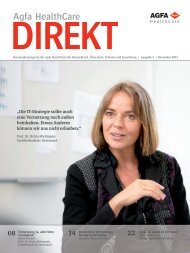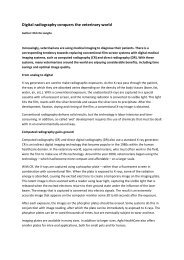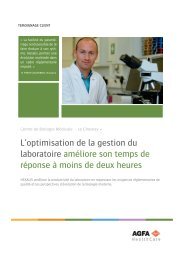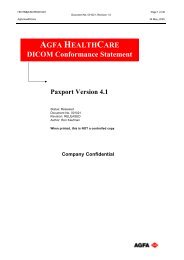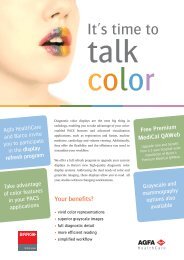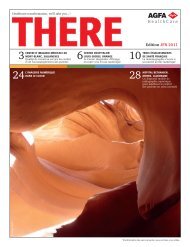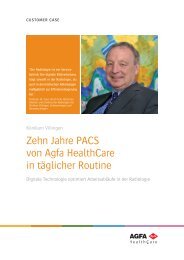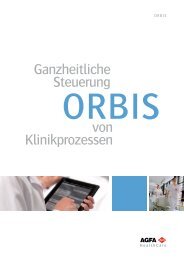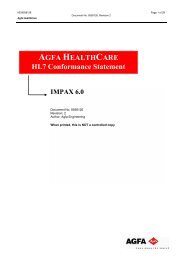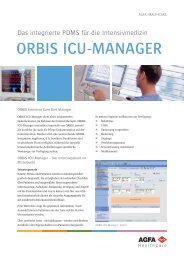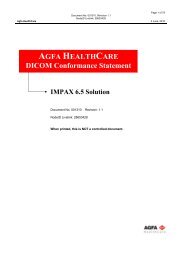Edition 4 - Agfa HealthCare
Edition 4 - Agfa HealthCare
Edition 4 - Agfa HealthCare
Create successful ePaper yourself
Turn your PDF publications into a flip-book with our unique Google optimized e-Paper software.
On-site Occupational Health<br />
Center relies on <strong>Agfa</strong> Healthcare’s<br />
professionalism and efficient service<br />
in its move to digital x-ray chest<br />
screening of employees<br />
Impala Platinum Refinery, the world’s second largest platinum producer,<br />
invested in <strong>Agfa</strong> <strong>HealthCare</strong>’s CR and IMPAX PACS solutions to perform<br />
obligatory health checks on its employees<br />
INTERVIEWEE Dr. Lucas van der Berg; Manager of Safety, Health, Environment and Quality (SHEQ) at the Occupational Health Center<br />
Hospital Impala Platinum Refinery, Springs, South Africa<br />
With more than 55,000 employees<br />
and contractors company-wide, Impala<br />
Platinum Ltd. Refinery is one of South<br />
Africa’s largest companies. Until recently,<br />
the company used analog film/screen<br />
systems to produce all legally required<br />
workers’ chest exams. There is also an<br />
obligation to retain such images for<br />
40 years. In late 2008, the Occupational<br />
Health Center at one of Impala’s major<br />
sites switched from analog to digital<br />
imaging using <strong>Agfa</strong> <strong>HealthCare</strong>’s CR<br />
30-X computed radiography system<br />
and IMPAX 6.0 Picture Archiving and<br />
Communications System (PACS) for image<br />
networking and storage.<br />
On-site Occupational Health<br />
Center annually performs<br />
5,000 x-ray screenings of<br />
refinery workers<br />
Impala Platinum Ltd. mines, refines<br />
and sells platinum group metals as<br />
well as base metals like nickel, copper<br />
and cobalt. One of platinum’s major<br />
uses outside its precious metal status<br />
is the main catalyst in automotive<br />
catalytic converters used to reduce<br />
emission toxicity of cars, buses and<br />
trucks. Springs, South Africa, is home<br />
to Impala’s two major refineries<br />
that produce 99.99% pure platinum<br />
from partially refined ore from their<br />
Rustenburg mines 250 km away.<br />
The site employs about 1,000 full-time<br />
workers year round, but with parttime<br />
contractors hired during peak<br />
periods, that number can grow to<br />
over 3,000. All refinery workers – full<br />
time or contractor – must receive an<br />
“<strong>Agfa</strong> <strong>HealthCare</strong> offered us the best<br />
cost/value ratio with their digital<br />
radiography and PACS solutions,<br />
and we already knew about their<br />
professionalism and efficient<br />
service through the many years<br />
they maintained our original analog<br />
film/screen systems.”<br />
dr. Lucas van deR Berg,<br />
Manager of Safety, Health, Environment and<br />
Quality (SHEQ), Occupational Health Center<br />
annual chest x-ray in addition to one<br />
at pre-employment and when they exit<br />
the company. This is done through an<br />
on-site Occupational Health Center,<br />
part of Impala’s company-wide Safety,<br />
Health, Environment and Quality<br />
(SHEQ) department. The Springs SHEQ<br />
operation employs an Occupational<br />
Medicine Practitioner, two Occupational<br />
Health Practitioners, six nurses and a<br />
medical secretary. Part of the facility<br />
includes an x-ray section run by three of<br />
the staff members who are also qualified<br />
Supplementary Chest Radiographers.<br />
All of the nearly 5,000 chest x-rays<br />
performed on average each year are for<br />
screening purposes only. Additionally, the<br />
Springs site also contracts its services to<br />
interested outside companies who wish<br />
to outsource annual, pre-employment or<br />
exit medicals.<br />
The best cost/value ratio to<br />
capture, digitize, display and<br />
archive digital chest images<br />
The migration to a fully digital workflow<br />
occurred gradually. “We started three<br />
years ago by scanning chest exam<br />
films and transferring the images to<br />
Digital Video Disc (DVD),” says Dr.<br />
Lucas van der Berg, Manager of SHEQ<br />
at the Occupational Health Center.<br />
12 THERE



